-
- PCB TYPE
- PRINTED CIRCUIT BOARD PROTOTYPE ALUMINUM PRINTED CIRCUIT BOARD R&F PCB FPC HIGH FREQUENCY PCB HIGH-TG PCB HEAVY COPPER PCB HDI PCB PCB FOR LIGHTING METAL CORE PCB
time:Jun 30. 2025, 12:08:45
Introduction: The Evolution of PCB Technology
In the fast - paced electronics industry, the demand for high - performance, reliable, and energy - efficient solutions has never been greater. Among the key advancements meeting these needs, Aluminum Printed Circuit Boards (PCBs) have emerged as a transformative technology. Unlike traditional fiberglass - based PCBs, aluminum PCBs leverage the unique properties of aluminum to address critical challenges in thermal management, mechanical robustness, and design flexibility. This article provides an in - depth exploration of aluminum PCBs, examining their technical architecture, manufacturing processes, performance advantages, diverse industry applications, and future trends. As electronics continue to shrink in size while increasing in power, understanding the capabilities of aluminum PCBs is essential for engineers and industry professionals seeking to develop cutting - edge solutions.
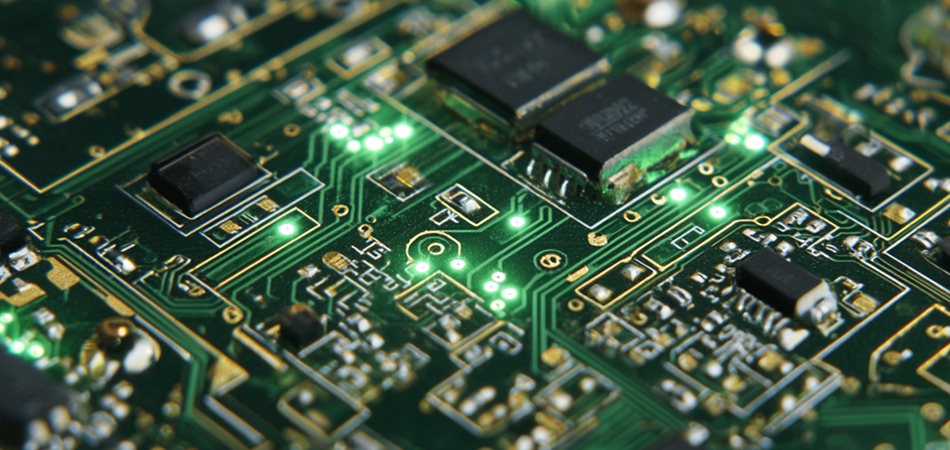
The Multilayer Structure of Aluminum PCBs
The Copper Circuit Layer: Electrical Conductivity at its Core
The uppermost layer of an aluminum PCB is a high - purity copper foil, carefully etched to form a network of conductive traces. This layer serves as the nervous system of the electronic device, directing electrical current with minimal resistance. The copper’s thickness is customized to the specific power requirements of the application, with thicker foils used in high - power designs to handle higher currents and reduce energy losses. Advanced CAD software is employed to optimize trace geometry, ensuring uniform current distribution and minimizing voltage drops, which is crucial for maintaining device performance.
The Dielectric Layer: Balancing Insulation and Heat Transfer
Sandwiched between the copper circuit layer and the aluminum substrate, the dielectric layer plays a dual role: electrical isolation and thermal conduction. Composed of specialized thermally conductive polymers embedded with ceramic fillers (such as aluminum oxide or boron nitride), this layer acts as a thermal bridge. It prevents electrical short - circuits while facilitating efficient heat transfer from the copper traces to the aluminum base. The dielectric constant and thermal conductivity of this layer are critical parameters, with modern formulations designed to maximize heat dissipation while maintaining electrical insulation.
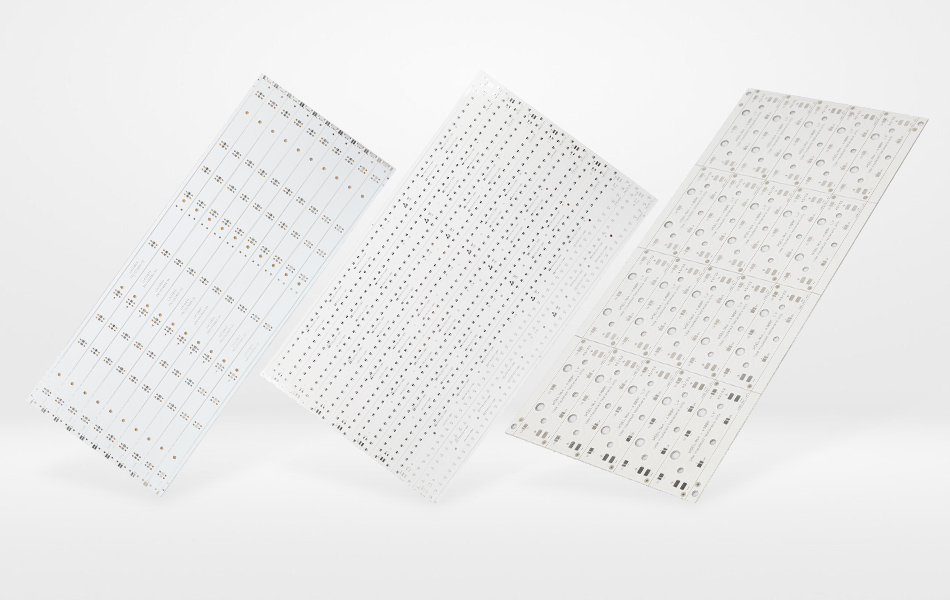
Thermal Management: A Key Advantage of Aluminum PCBs
The Impact of Heat on Electronic Components
Excessive heat is a primary cause of component degradation and failure in electronic devices. High temperatures can lead to:
Reduced Component Lifespan: Accelerated wear and tear of electronic components, leading to premature failure.
Performance Degradation: Decreased efficiency and reliability of components, including reduced luminous efficacy in LEDs and decreased conductivity in semiconductors.
Thermal Stress: Mechanical stress caused by thermal expansion and contraction, which can lead to cracks in solder joints and component delamination.
Aluminum PCBs address these challenges by providing an efficient thermal pathway, allowing heat to be dissipated quickly and effectively, thus maintaining component performance and longevity.
Thermal Resistance and Heat Dissipation Mechanisms
The thermal resistance (Rth) of an aluminum PCB is a critical performance metric, indicating how effectively heat is transferred from the component to the environment. Key factors influencing thermal resistance include:
Material Properties: The thermal conductivity of the copper, dielectric, and aluminum layers.
Design Features: The layout of thermal vias, which are plated through - holes that facilitate vertical heat transfer from the copper layer to the aluminum substrate.
Heat Sink Integration: The design and integration of external heat sinks, which expand the surface area available for heat dissipation through convection and radiation.
Thermal vias, often filled with thermally conductive materials, play a pivotal role in minimizing thermal resistance by creating direct heat transfer pathways. Additionally, the aluminum substrate itself acts as a large - area heat sink, distributing heat evenly and efficiently.
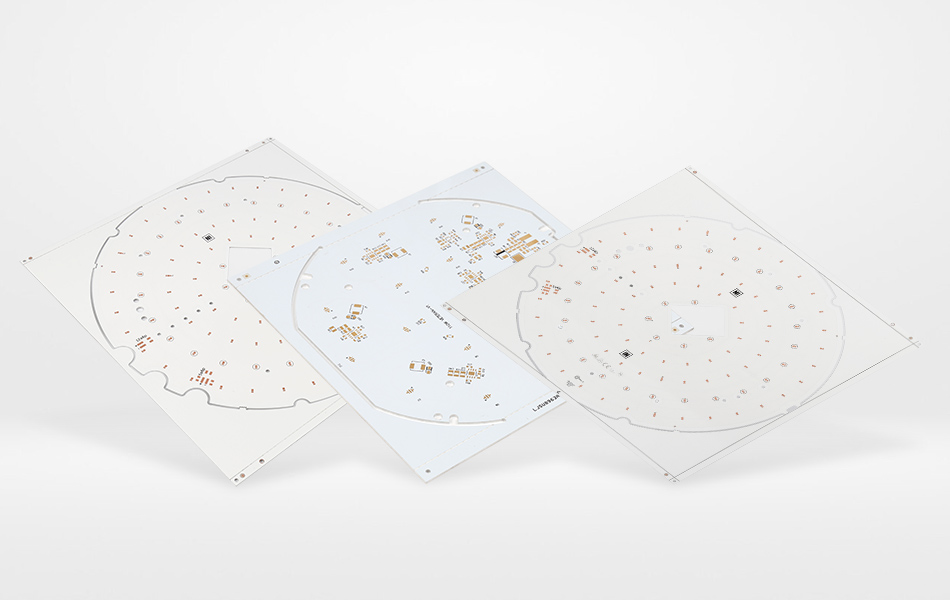
Design Considerations for Aluminum PCBs
Thermal Design Principles
Effective thermal design is crucial for maximizing the performance of aluminum PCBs:
Component Placement: Strategic placement of high - power components to facilitate heat dissipation, often clustering them to leverage shared thermal pathways.
Thermal Spacing: Ensuring adequate distance between heat - generating components to prevent mutual heating and the formation of hotspots.
Thermal Vias: Strategic placement and optimization of thermal vias to minimize thermal gradients and ensure uniform heat distribution.
Electrical Design Considerations
Trace Width and Thickness: Calculating trace dimensions to handle operating currents without excessive heating, considering factors such as copper thickness and ambient temperature.
Ground Plane Design: Utilizing large copper areas as ground planes to serve as heat spreaders and reduce electrical noise.
Voltage Clearance: Maintaining sufficient distance between high - voltage traces and the aluminum substrate to prevent electrical arcing and ensure safety.
Mechanical and Environmental Factors
Material Selection: Choosing appropriate aluminum alloys and surface treatments to withstand specific environmental conditions, such as corrosion - resistant alloys for outdoor applications.
Mechanical Robustness: Designing the PCB with appropriate thickness and reinforcing features to endure mechanical stress, vibration, and impact.
Thermal Expansion Matching: Ensuring compatibility between the coefficients of thermal expansion (CTE) of the PCB layers to prevent delamination and mechanical failure during thermal cycling.
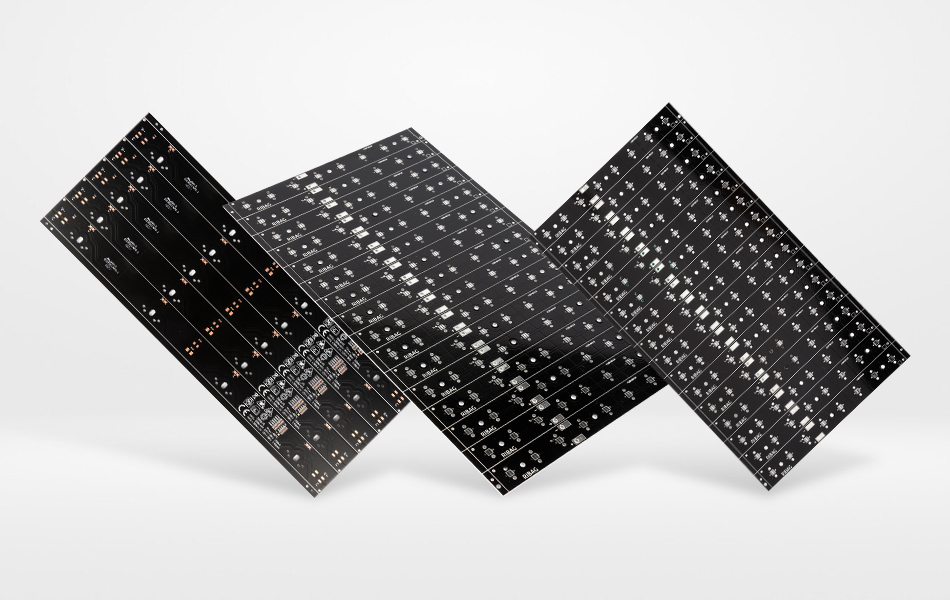
Manufacturing Processes for Aluminum PCBs
Material Preparation and Lamination
Aluminum Substrate Pretreatment: Thorough cleaning and surface activation to remove contaminants and enhance adhesion of the dielectric layer, often involving degreasing, etching, or plasma treatment.
Dielectric Lamination: Bonding the copper foil, dielectric prepreg, and aluminum substrate under controlled heat and pressure in a vacuum laminator to ensure a void - free bond and uniform thickness. This process is critical for achieving consistent thermal and electrical performance.
Circuit Patterning and Via Formation
Photolithography: Using advanced imaging techniques, such as laser direct imaging (LDI), for high - resolution trace definition, followed by etching with eco - friendly solutions to form the copper circuitry.
Precision Drilling: Employing specialized drill bits, often diamond - coated, for accurate via placement in the aluminum substrate, with coolant systems to minimize burr formation and tool wear.
Via Processing: Applying electroless copper plating to via walls for electrical connectivity, with optional filling using thermally conductive materials to enhance heat transfer efficiency.
Surface Finishing and Quality Assurance
Lead - Free Surface Finishes: Implementing environmentally friendly finishes, such as tin - based alloys, electroless nickel immersion gold (ENIG), or organic solderability preservatives (OSP), to ensure solderability and corrosion resistance.
Thermal Performance Testing: Using standardized methods to measure heat dissipation efficiency and validate thermal performance, ensuring the PCB meets application requirements.
Reliability Testing: Subjecting PCBs to rigorous environmental tests, including temperature cycling, humidity, and vibration testing, to ensure reliability in real - world applications.
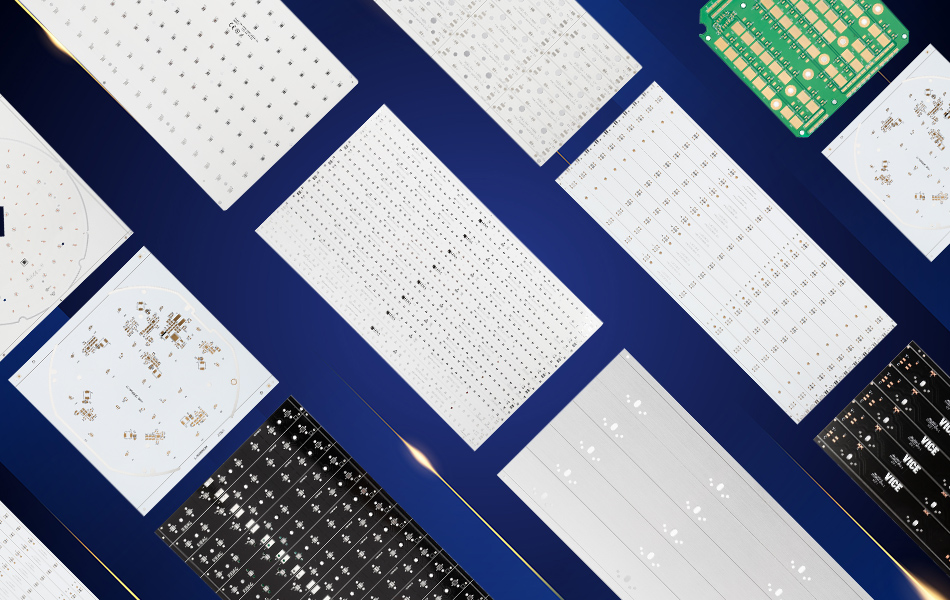
Advantages of Aluminum PCBs over Traditional PCBs
Superior Thermal Management
The most significant advantage of aluminum PCBs is their exceptional thermal conductivity, which allows for efficient heat dissipation. This leads to lower operating temperatures, improved component reliability, and extended product lifespan compared to traditional fiberglass PCBs.
Mechanical Robustness
Aluminum PCBs offer greater mechanical strength and durability, making them suitable for applications subject to vibration, 冲击,and mechanical stress. The aluminum substrate provides a rigid foundation, reducing the risk of component damage and board deformation.
Design Flexibility
The combination of thermal efficiency and mechanical strength allows for more flexible design possibilities. Aluminum PCBs can be designed to be thinner and lighter than traditional PCBs, enabling more compact and lightweight electronic devices.
Environmental Benefits
Aluminum is highly recyclable, making aluminum PCBs a more environmentally friendly choice compared to traditional PCBs. Additionally, their thermal efficiency reduces energy consumption, contributing to lower carbon footprints.
Industry Applications of Aluminum PCBs
LED Lighting Systems
Aluminum PCBs are widely used in LED lighting applications, from streetlights and architectural lighting to automotive and specialty lighting:
High - Power LED Lighting: Efficient thermal management ensures consistent light output and extended lifespan in high - power LED arrays.
Outdoor Lighting: Corrosion - resistant aluminum alloys and robust designs make them suitable for outdoor environments.
Automotive Lighting: Ability to withstand vibration and temperature fluctuations makes them ideal for vehicle headlights and interior lighting.
Power Electronics
In power - intensive applications, aluminum PCBs excel at managing heat generated by high - power components:
Power Supplies: Efficient heat dissipation in power supply units, improving reliability and efficiency.
Motor Control Systems: Robust thermal management for motor drivers and controllers in industrial applications.
Renewable Energy Systems: Used in solar inverters and wind turbine control systems, ensuring reliable operation in harsh environmental conditions.
Consumer Electronics
Aluminum PCBs enable the development of sleek, high - performance consumer devices:
Portable Electronics: Lightweight and thin designs for smartphones, tablets, and wearable devices.
Audio Equipment: Reduced thermal stress on components ensures high - quality sound output in audio amplifiers and speakers.
Home Appliances: Energy - efficient and reliable operation in smart home devices and kitchen appliances.
Medical and Healthcare Devices
Precision and reliability are paramount in medical applications, where aluminum PCBs play a key role:
Diagnostic Equipment: Stable performance in medical imaging and diagnostic devices.
Surgical Instruments: Sterilizable designs for surgical lighting and precision medical tools.
Wearable Medical Monitors: Compact and reliable designs for continuous health monitoring devices.
Aerospace and Defense
Aluminum PCBs meet the rigorous requirements of aerospace and defense applications:
Avionics Systems: Lightweight and durable designs for aircraft navigation and communication systems.
Military Electronics: Robust performance in harsh environments, including extreme temperatures and vibrations.
Satellite Technology: Low - outgassing materials suitable for space applications.
Future Trends in Aluminum PCB Technology
Advanced Material Innovations
Nano - Enhanced Materials: Incorporation of nanomaterials like graphene and boron nitride to further enhance thermal conductivity and electrical insulation.
Biodegradable and Recyclable Formulations: Development of eco - friendly dielectrics and recycled aluminum substrates to reduce environmental impact.
Composite Materials: Creation of metal matrix composites combining aluminum with ceramic fillers for tailored thermal and mechanical properties.
Manufacturing Process Advancements
Additive Manufacturing: 3D printing technologies for rapid prototyping and customized aluminum PCB designs, enabling complex geometries and integrated heat sink structures.
Laser - Based Fabrication: Precision laser drilling and etching for microvias and fine - line traces in high - density PCBs.
Automated and Smart Manufacturing: Implementation of AI and machine learning for real - time process optimization and quality control.
Integration with Emerging Technologies
5G and IoT Devices: Aluminum PCBs designed for high - frequency applications and seamless integration with internet - connected systems.
Artificial Intelligence and Edge Computing: High - performance PCBs for AI accelerators and edge computing devices requiring efficient thermal management.
Electric Vehicles (EVs): Advanced aluminum PCBs for EV battery management systems, power inverters, and charging infrastructure.
Miniaturization and High - Density Integration
Micro - Electronics: Aluminum PCBs supporting the miniaturization of electronic devices through high - density component integration.
3D Packaging: Development of stacked and embedded component technologies on aluminum PCBs for compact and powerful electronic systems.
Conclusion: The Indispensable Role of Aluminum PCBs
Aluminum PCBs have revolutionized the electronics industry by addressing critical challenges in thermal management, mechanical robustness, and design flexibility. From LED lighting and power electronics to consumer devices and advanced aerospace systems, their unique capabilities have made them indispensable in modern electronics manufacturing. As technology continues to advance, aluminum PCBs will play an even more significant role in enabling the development of smaller, more powerful, and more reliable electronic devices. By embracing ongoing material innovations and manufacturing advancements, aluminum PCBs will continue to drive progress in the electronics industry, ensuring that the next generation of technology is both high - performance and environmentally sustainable.

Got project ready to assembly? Contact us: info@apollopcb.com



We're not around but we still want to hear from you! Leave us a note:

Leave Message to APOLLOPCB
